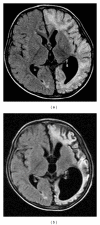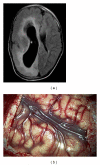Outcomes of disconnective surgery in intractable pediatric hemispheric and subhemispheric epilepsy
- PMID: 22518176
- PMCID: PMC3299362
- DOI: 10.1155/2012/527891
Outcomes of disconnective surgery in intractable pediatric hemispheric and subhemispheric epilepsy
Abstract
Objectives: To study the outcome of disconnective epilepsy surgery for intractable hemispheric and sub-hemispheric pediatric epilepsy.
Methods: A retrospective analysis of the epilepsy surgery database was done in all children (age <18 years) who underwent a peri-insular hemispherotomy (PIH) or a peri-insular posterior quadrantectomy (PIPQ) from April 2000 to March 2011. All patients underwent a detailed pre surgical evaluation. Seizure outcome was assessed by the Engel's classification and cognitive skills by appropriate measures of intelligence that were repeated annually.
Results: There were 34 patients in all. Epilepsy was due to Rasmussen's encephalitis (RE), Infantile hemiplegia seizure syndrome (IHSS), Hemimegalencephaly (HM), Sturge Weber syndrome (SWS) and due to post encephalitic sequelae (PES). Twenty seven (79.4%) patients underwent PIH and seven (20.6%) underwent PIPQ. The mean follow up was 30.5 months. At the last follow up, 31 (91.1%) were seizure free. The age of seizure onset and etiology of the disease causing epilepsy were predictors of a Class I seizure outcome.
Conclusions: There is an excellent seizure outcome following disconnective epilepsy surgery for intractable hemispheric and subhemispheric pediatric epilepsy. An older age of seizure onset, RE, SWS and PES were good predictors of a Class I seizure outcome.
Figures







References
-
- Robert HAH. Seizures in childhood. In: Behrman RE, Kliegman RM, Jenson HB, editors. Nelson Textbook of Pediatrics. 16th edition. WB Saunders; 2000. pp. 1813–1825.
-
- Radhakrishnan K, Pandian JD, Santhoshkumar T, et al. Prevalence, knowledge, attitude and practice of epilepsy in Kerala, South India. Epilepsia. 2000;41(8):1027–1035. - PubMed
-
- Cross JH. Epilepsy surgery in childhood. Epilepsia. 2002;43(3):65–70. - PubMed
-
- Daniel RT, Thomas SG, Thomas M. Role of surgery in pediatric epilepsy. Indian Pediatrics. 2007;44(4):263–273. - PubMed
-
- Janszky J, Rásonyi G, Fogarasi A, et al. Surgically treatable epilepsy—a review. Orvosi Hetilap. 2001;142(30):1597–1604. - PubMed
LinkOut - more resources
Full Text Sources
Miscellaneous

